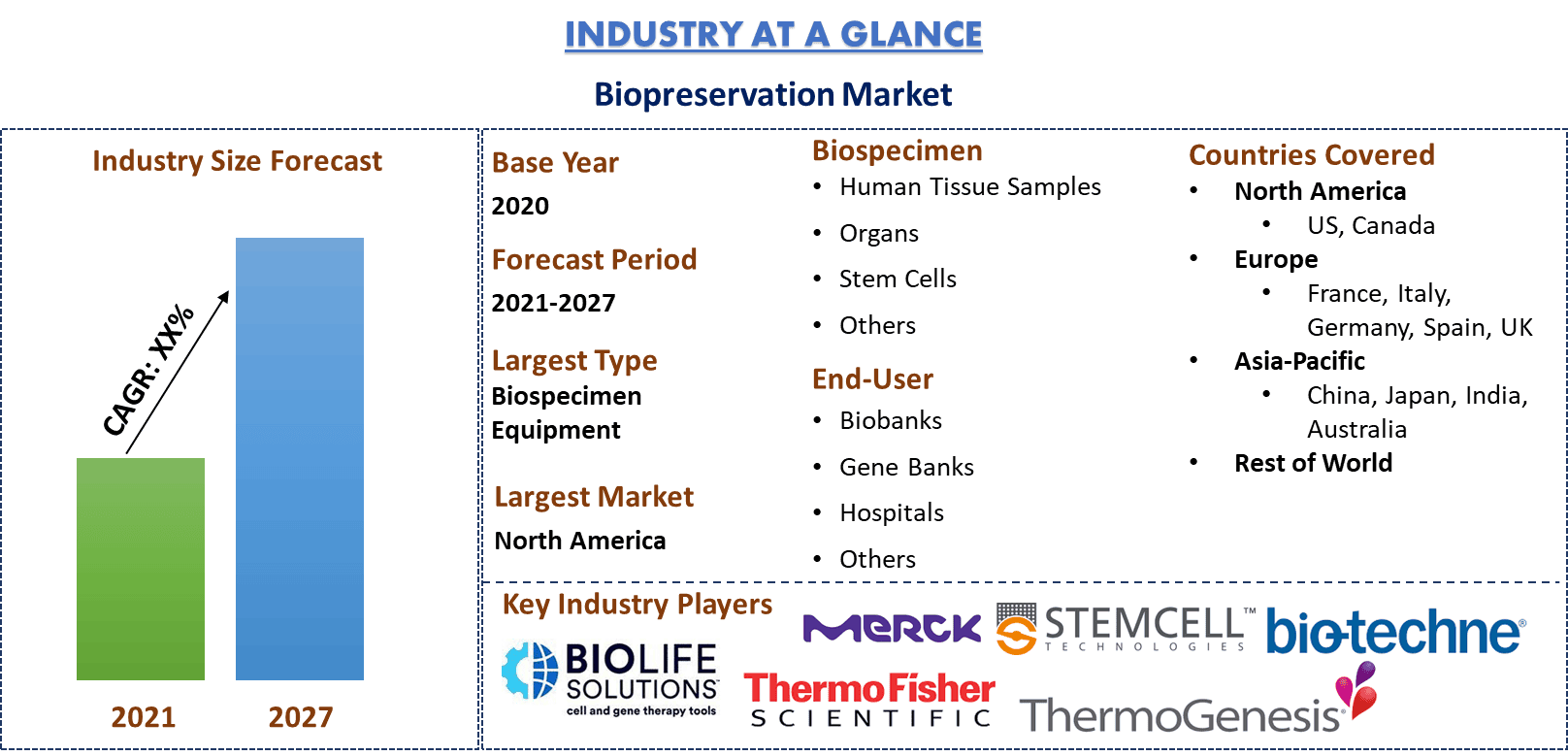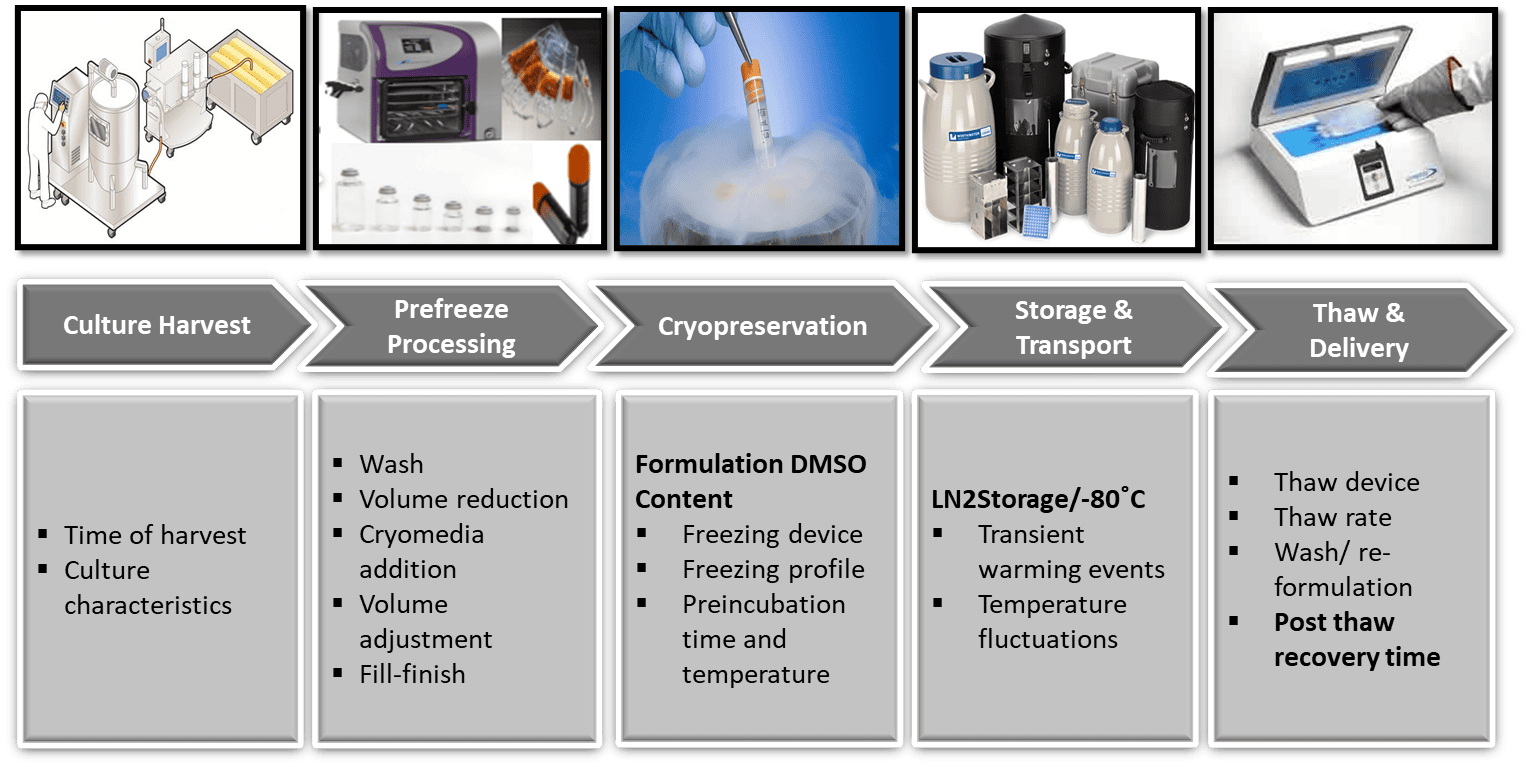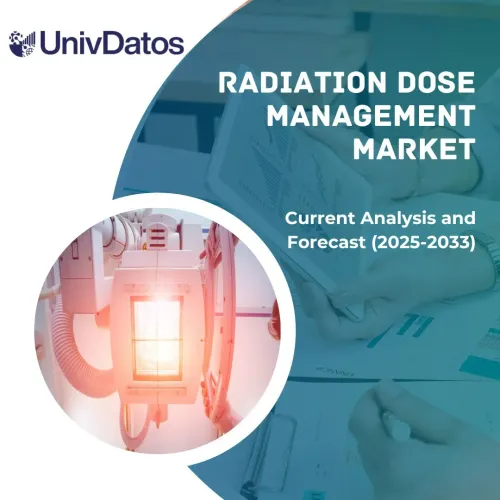- Home
- About Us
- Industry
- Services
- Reading
- Contact Us
Biopreservation Market: Current Analysis and Forecast (2021-2027)
Emphasis on Type (Biopreservation Media, Biospecimen Equipment, Freezers, Cryogenic Storage Systems, Thawing Equipment, Refrigerators); Biospecimen (Human Tissue Samples, Organs, Stem Cells, Others); Application (Therapeutic Applications, Research Applications, Clinical Trials, Others); End-User (Biobanks, Gene Banks, Hospitals, Others); Region and Country

Biopreservation Market was valued at US$ 5 billion in 2020 and is expected to grow at a CAGR of 14% over the forecast period (2021-2027). Biopreservation provides a broad range of therapeutic and industrial applications for developing cell-based technologies. It is used in numerous healthcare facilities to conserve the functionality and integrity of clinical trial materials such as eggs, sperm, embryos, and other biological materials. Biopreservation preserves the purity and sustainability of biospecimens while also extending their shelf life. Biobanking, a form of biopreservation, is commonly used in medical research related to precision medicine and genomics research. The basic role of biobanks is to collect, process, and store samples and associated records. For instance, in June 2021, Biodesix Inc. a lung cancer diagnostic solutions company, announced a strategic partnership with Datavant to help protect, match, and share health data. Through this partnership, Biodesix anonymizes the lung cancer portion of its expansive sample and data biobank using Datavant’s proprietary tokenization process and connects it to multiple real-world data sets while compliantly and securely protecting patient privacy.
Further, the progression of regenerative medicine for treating and controlling various chronic diseases such as cancer, heart failure, diabetes, including Covid-19 are adding pace to the growth of the biopreservation market. According to the American Cancer Society, in 2020, there were approximately 89,500 cancer cases diagnosed, and about 9,270 cancer deaths in adolescents and young adults aged between 15 to 39 years in the US were recorded. Hence, regenerative medicine and personalized medicine are expected to witness healthy growth in the future contributing to the overall growth of biopreservation market. Due to government-imposed lockdowns to prevent the spreading of Covid-19, the global biopreservation market has seen a small decline in the short term. Because of the pandemic, the worldwide supply chain stopped operating, which impacted the market. However, in the mid of the pandemic, there has been a rising demand for the preservation of plasmas, bodily fluids, tissues, and organs. Thus, resulted in the positive growth for biopreservation services. The market would remain bullish in the upcoming year. For instance, in March 2020, Columbia University Vagelos College of Physicians and Surgeons, U.S., in partnership with New York-Presbyterian Hospital, established a COVID-19 Biobank as a centralized resource to collect, store, and disseminate biological specimens and clinical data for researchers at Columbia University and elsewhere.
Value Chain Analysis of Biopreservation Market

Thermo Fisher Scientific Inc., Merck KGaA, ThermoGenesis Holdings, Inc., Bio-Techne Corporation, BioLife Solutions, Inc., Exact Sciences Corporation, Princeton CryoTech, Inc., Stemcell Technologies, Inc., OPS Diagnostics, AMS Biotechnology are some of the prominent players operating in the biopreservation market. Several M&As along with partnerships have been undertaken by these players to facilitate customers with hi-tech and innovative products.
Insights Presented in the Report
“Amongst Type, Biospecimen Equipment segment holds the major share”
Based on types, the market is bifurcated into biopreservation media, biospecimen equipment, freezers, cryogenic storage systems, thawing equipment, and refrigerators. The biospecimen equipment segment grabbed the major market in 2020, owing to increased investments from private and public organizations for research and development of cell and gene therapies and increasing acceptance of refrigerators, and biological freezers for the preservation of biological specimens.
“Amongst Biospecimen, Stem Cells segment is anticipated to grow at the highest CAGR during the analyzed period”
Based on biospecimen, the market is bifurcated into human tissue samples, organs, stem cells, and others. The stem cells segment dominated the market in 2020 due to the augmenting awareness of people about conserving cord blood stem cells of newborns to treat chronic diseases like cancer and others.
“Amongst Application, Therapeutic Applications segment holds the major share”
Based on application, the market is bifurcated into therapeutic applications, research applications, clinical trials, and others. The therapeutic applications segment dominated the market in 2020. The highest growth of the segment can be accredited to the advancements in the fields of regenerative medicine, personalized medicine, and biobanking.
“Amongst End-User, Biobank segment is anticipated to grow at the highest CAGR during the analyzed period”
Based on end-user, the market is bifurcated into biobanks, gene banks, hospitals, and others. The biobanks segment accounted for major revenue share in 2020, due to the increasing demand for conserving biospecimens, tissues, organs, and stem cells for various research purposes.
“North America signifies one of the largest markets of Biopreservation market”
For a better understanding of the market dynamics of the Biopreservation market, a detailed analysis was conducted for different regions across the globe including North America (United States, Canada, and the Rest of North America), Europe (Germany, France, Italy, Spain, United Kingdom and Rest of Europe), Asia-Pacific (China, Japan, India, Australia, and Rest of APAC), Rest of World. North America constitutes a major market for Biopreservation and generated maximum revenue in 2020 owing to the high government funding, robust personal healthcare spending, developed awareness programs, rapid acceptance of new analytical techniques, and the presence of skilled professionals and physicians.
Reasons to buy this report:
- The study includes market sizing and forecasting analysis validated by authenticated key industry experts
- The report presents a quick review of overall industry performance at one glance
- The report covers an in-depth analysis of prominent industry peers with a primary focus on key business financials, product portfolio, expansion strategies, and recent developments
- Detailed examination of drivers, restraints, key trends, and opportunities prevailing in the industry
- The study comprehensively covers the market across different segments
- Deep dive regional level analysis of the industry
Customization Options:
The Biopreservation Market can further be customized as per the requirement or any other market segment. Besides this, UMI understands that you may have your own business needs, hence feel free to connect with us to get a report that completely suits your requirements.
Table of Content
Analyzing the historical market, estimation of the current market, and forecasting the future market of the Global Biopreservation Market were the three major steps undertaken to create and analyze the adoption of biopreservation in different segments across major regions globally. Exhaustive secondary research was conducted to collect the historical market numbers and estimate the current market size. Secondly, to validate these insights, numerous findings and assumptions were taken into consideration. Moreover, exhaustive primary interviews were also conducted, with industry experts across the value chain of the biopreservation sector. Post assumption and validation of market numbers through primary interviews, we employed a botton-up approach to forecast the complete market size. Thereafter, market breakdown and data triangulation methods were adopted to estimate and analyze the market size of segments and sub-segments the industry pertains to. Detailed methodology is explained below:
Analysis of Historical Market Size
Step 1: In-Depth Study of Secondary Sources:
Detailed secondary study was conducted to obtain the historical market size of the biopreservation market through company internal sources such as annual reports & financial statements, performance presentations, press releases, etc., and external sources including journals, news & articles, government publications, competitor publications, sector reports, third-party database, and other credible publications.
Step 2: Market Segmentation:
After obtaining the historical market size of the biopreservation market, we conducted a detailed secondary analysis to gather historical market insights and share for different segments for major regions. Major segments included in the report are type, biospecimen, application, and end-user. Further country-level analyses were conducted to evaluate the overall adoption of the biopreservation market in every region.
Step 3: Factor Analysis:
After acquiring the historical market size of different segments and sub-segments, we conducted a detailed factor analysis to estimate the current market size of biopreservation. Further, we conducted factor analysis using dependent and independent variables such as the growing advancements in biobanking and the increasing demand of conserving cord blood stem cells of newborns across the world will upsurge the demand for biopreservation. A thorough analysis was conducted for demand and supply-side scenarios considering top partnerships, merger and acquisition, business expansion, and product launches in the Biopreservation industry across the globe.
Current Market Size Estimate & Forecast
Current Market Sizing: Based on actionable insights from the above 3 steps, we arrived at the current market size, key players in the biopreservation market, and market shares of the segments. All the required percentage shares split, and market breakdowns were determined using the above-mentioned secondary approach and were verified through primary interviews.
Estimation & Forecasting: For market estimation and forecast, weights were assigned to different factors including drivers & trends, restraints, and opportunities available for the stakeholders. After analyzing these factors, relevant forecasting techniques i.e., the bottom-up approach was applied to arrive at the market forecast about 2027 for different segments and subsegments across the major markets globally. The research methodology adopted to estimate the market size encompasses:
- The industry’s market size, in terms of value (USD) and the adoption rate of biopreservation across the major markets domestically
- All percentage shares, splits, and breakdowns of market segments and sub-segments
- Key players in the biopreservation market in terms of services offered. Also, the growth strategies adopted by these players to compete in the fast-growing market
Market Size and Share Validation
Primary Research: In-depth interviews were conducted with the Key Opinion Leaders (KOLs) including Top Level Executives (CXO/VPs, Sales Head, Marketing Head, Operational Head, and Regional Head, Country Head, etc.) across major regions. Primary research findings were then summarized, and statistical analysis was performed to prove the stated hypothesis. Inputs from primary research were consolidated with secondary findings, hence turning information into actionable insights.
Split of Primary Participants in Different Regions
Market Engineering
Data triangulation technique was employed to complete the overall market estimation and to arrive at precise statistical numbers of each segment and sub-segment of the biopreservation market. Data was split into several segments & sub-segments post studying various parameters and trends in the areas of type, biospecimen, application, and end-user of the biopreservation market.
Main Objective of the Biopreservation Market Study
The current & future market trends of biopreservation were pinpointed in the study. Investors can gain strategic insights to base their discretion for investments from the qualitative and quantitative analysis performed in the study. Current and future market trends were determined the overall attractiveness of the market at a regional level, providing a platform for the industrial participant to exploit the untapped market to benefit as a first-mover advantage. Other quantitative goals of the studies include:
- Analyze the current and forecast market size of biopreservation in terms of value (USD). Also, analyze the current and forecast market size of different segments and sub-segments
- Segments in the study include areas of type, biospecimen, application, and end-user
- Define and analysis of the regulatory framework for the biopreservation industry
- Analyze the value chain involved with the presence of various intermediaries, along with analyzing customer and competitor behaviors of the industry
- Analyze the current and forecast market size of the biopreservation market for the major region
- Major regions studied in the report include North America (the United States and Canada), Europe (Germany, France, Italy, Spain, and United Kingdom), Asia-Pacific (China, Japan, India, and Australia), and Rest of the World
- Company profiles of the biopreservation market and the growth strategies adopted by the market players to sustain in the fast-growing market
- Deep dive regional level analysis of the industry
Related Reports
Customers who bought this item also bought











